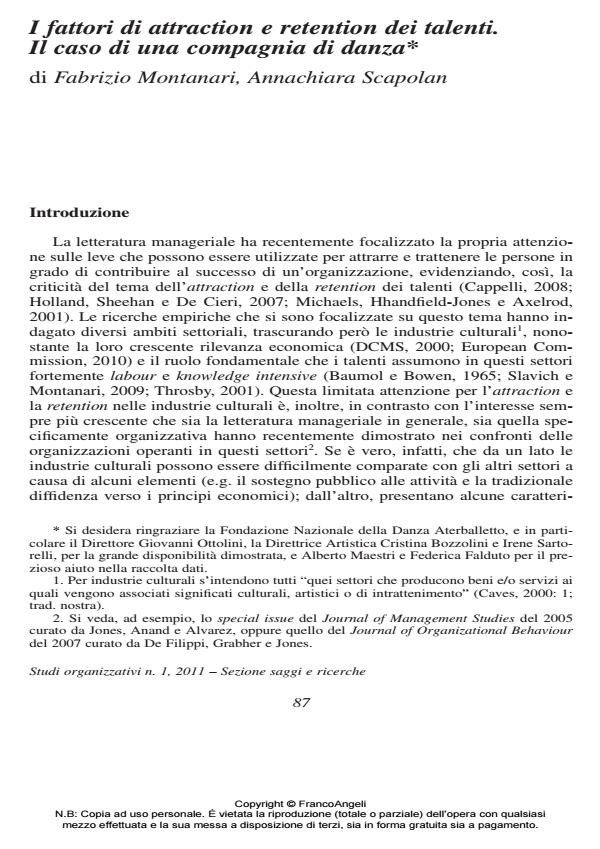Factors of talents’ attraction and retention. The case of a dance company
Journal title STUDI ORGANIZZATIVI
Author/s Fabrizio Montanari, Annachiara Scapolan
Publishing Year 2011 Issue 2011/1 Language Italian
Pages 25 P. 87-111 File size 532 KB
DOI 10.3280/SO2011-001004
DOI is like a bar code for intellectual property: to have more infomation
click here
Below, you can see the article first page
If you want to buy this article in PDF format, you can do it, following the instructions to buy download credits

FrancoAngeli is member of Publishers International Linking Association, Inc (PILA), a not-for-profit association which run the CrossRef service enabling links to and from online scholarly content.
Both management and academic literature have increasingly selected talents’ attraction and retention as an important area for research. Despite such a great attention devoted to this issue, there are still some under-investigated areas of interest. For example, previous research has devoted limited attention to cultural industries despite the fact that talents are the key asset of the organizations operating in these industries. Therefore, this paper aims at exploring this under-investigated issue by addressing three research questions. First, we will analyze a cultural organization’s characteristics that are able to attract and retain creative talents; second, we will investigate if attraction and retention are influenced just by organizational elements or also by external factors such as the city where the organization is located. Finally, we will analyze potential differences between attraction and retention factors. In doing so, we will analyze the case of the most important Italian dancing company - Fondazione della Danza Aterballetto. We combined different qualitative methods such as interviews, document analysis, and direct observation. Findings show that a cultural organization’s characteristics that are able to attract and retain creative talents are partially different from those highlighted by previous literature. In particular, the most important attraction factor seems to be the opportunity to work with the main choreographer, while the most important reasons to stay are represented by the creative process and the possibility to meet and work with other artists operating in different creative sectors. This opportunity is appreciated by the dancers who perceive Aterballetto as the centre of a relational network, which extends beyond the organizational boundaries. In the same way, the local socio-cultural context plays an important role in influencing the retention of dancers. Finally, the attraction factors are partially different from the retention ones. At the end of the paper, some possible future lines of research are presented and discussed.
Keywords: Talent management, performing arts, HRM, creativity
- Creatività e senso del luogo: uno studio sulle dinamiche identitarie in un cluster creativo Fabrizio Montanari, Damiano Razzoli, in STUDI ORGANIZZATIVI 1/2019 pp.64
DOI: 10.3280/SO2019-001003 - The impact of festivals on the image of a cultural industry: The case of the new Italian dance platform Ludovica Leone, Fabrizio Montanari, in Poetics 101630/2022 pp.101630
DOI: 10.1016/j.poetic.2021.101630
Fabrizio Montanari, Annachiara Scapolan, I fattori di attraction e retention dei talenti. Il caso di una compagnia di danza in "STUDI ORGANIZZATIVI " 1/2011, pp 87-111, DOI: 10.3280/SO2011-001004